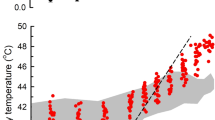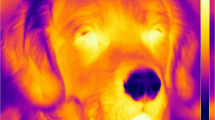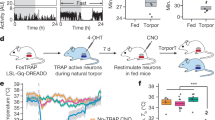Abstract
FEVER is considered to be a universal response of warm-blooded animals to endotoxins1. Although during a fever a mammal uses behavioural as well as physiological means to increase its body temperature2, it is not known whether fever develops in an animal such as a lizard which regulates its body temperature largely by behaviour. For example, the desert iguana (Dipsosaurus dorsalis) regulates its body temperature close to 38.5° C if placed in a chamber with a temperature gradient3. If this lizard is placed in a temperature chamber in which one end is heated to above the animal's lethal body temperature (50° C) and the other end is maintained at room temperature, the lizard regulates its temperature by moving back and forth between the two sides4. Under these conditions, one can determine its high and low set-points (Fig. 1). The central nervous control of temperature in an ectotherm, such as a lizard, and an endotherm, such as the rabbit, appears to be quite similar. For example, both possess a hypothalamus which is thermally sensitive5,6, and lesions in the posterior hypothalamus in both lizards4 and mammals7 lead to an inability to maintain a high body temperature.
This is a preview of subscription content, access via your institution
Access options
Subscribe to this journal
Receive 51 print issues and online access
$199.00 per year
only $3.90 per issue
Buy this article
- Purchase on Springer Link
- Instant access to full article PDF
Prices may be subject to local taxes which are calculated during checkout
Similar content being viewed by others
References
Atkins, E., and Bodel, P., New Engl J. Med., 286, 27–34 (1972).
Cabanac, M., in Essays on temperature regulation (edit. by Bligh, J., and Moore, R.), 19–36 (North-Holland, Amsterdam, 1972).
DeWitt, C. B., Physiol. Zool., 40, 49–66 (1967).
Kluger, M., Tarr, R. S., and Heath, J. E., Physiol. Zool., 46, 79–84 (1973).
Cabanac, M., Hammel, T., and Hardy, J. D., Science, 158, 1050–1051 (1967).
Hammel, H. T., Caldwell, F. T., jun., and Abrams, R. M., Science, 156, 1260 (1967).
Ranson, S. W., and Magoun, H. W., Ergeb. Physiol. Biol. Chem. exp. Pharmakol., 41, 56–163 (1939).
Reichenbach-Klinke, H., and Elkan, E., in The principal diseases of lower vertebrates, 396 (Academic Press, London, 1965).
Author information
Authors and Affiliations
Rights and permissions
About this article
Cite this article
VAUGHN, L., BERNHEIM, H. & KLUGER, M. Fever in the lizard Dipsosaurus dorsalis. Nature 252, 473–474 (1974). https://doi.org/10.1038/252473a0
Received:
Revised:
Issue Date:
DOI: https://doi.org/10.1038/252473a0
This article is cited by
-
Shrimp (Penaeus vannamei) survive white spot syndrome virus infection by behavioral fever
Scientific Reports (2023)
-
Fever as an evolutionary agent to select immune complexes interfaces
Immunogenetics (2022)
-
Transmission and terrestrial dispersal of non-native ectosymbionts on invasive crayfish
Hydrobiologia (2018)
-
Getting into hot water: sick guppies frequent warmer thermal conditions
Oecologia (2016)
-
Fever and the thermal regulation of immunity: the immune system feels the heat
Nature Reviews Immunology (2015)
Comments
By submitting a comment you agree to abide by our Terms and Community Guidelines. If you find something abusive or that does not comply with our terms or guidelines please flag it as inappropriate.



